Salads and sandwiches’ primary ingredients include cucumbers, a gardener favourite as well as of commercial farmers. But they are susceptible to different cucumber pests and diseases that may affect the plants’ health and production. Understand and deal with these challenges effectively to ensure a successful cucumber harvest.
To ensure a successful cucumber crop, you must understand and effectively address these challenges. By mastering them and using proper management techniques, you can guarantee a successful cucumber harvest. Effectively managing these challenges can increase the effectiveness of cucumber harvesting. This holistic guide explores five common pests and diseases, describing their characteristics, features, symptoms, signs of development, impact on cucumber fields, and strategies for management.
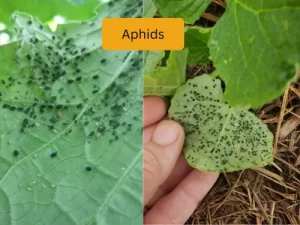
Cucumbers infected with Aphids
Features: Aphids are tiny, sap-feeding insects that may be green but can also show color variation. They aggregate at the bottom of leaves or shoots.
Symptoms: Aphids induce leaf rolling, discoloration and stunting. They secrete a viscous material known as honeydew that causes sooty mould.
Management: Aphids are destroyed by natural predators, such as ladybugs and lacewings. Other methods include use of insecticidal soaps, neem oil and horticultural oils. Allow beneficial insects to thrive by planting companion plants such as marigolds.
Solution: To combat Aphids on cucumbers, ‘Beveria WP‘ offers a bioinsecticide solution based on Beauveria bassiana. This product effectively controls Aphids naturally, suitable for use on both indoor and outdoor plants. It’s applied either as a foliar spray or soil drench, with specific dosages for each method provided on the product label. ‘Beauveria WP’ works by the fungus penetrating and colonizing the insect’s body, ultimately leading to the pest’s death. It’s eco-friendly, safe for humans and the environment, and fits well into integrated pest management programs.
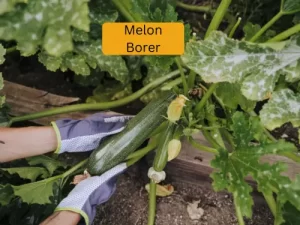
Cucumbers infected with melon borer
Features: Melon borers are destructive pests that lay eggs on the surface of melon plants. The larvae bore into the stems, vines, and fruit, causing extensive damage. They are typically brown or gray in color and can vary in size.
Symptoms: Infestation by melon borers leads to wilting, yellowing, and dieback of vines and leaves. Entry holes can be seen on the surface of the fruit, often accompanied by frass, or insect waste. Severe infestations can result in reduced fruit yield and quality.
Management: Natural predators like parasitic wasps and beneficial nematodes can help control melon borer populations. Additionally, cultural practices such as crop rotation and sanitation can reduce the risk of infestation. Regular monitoring and early detection are crucial for effective management.
Solution: For combating melon borers, BT Thuricide offers an effective bioinsecticide solution based on Bacillus thuringiensis var. kurstaki. This product targets the larvae of the melon borer specifically, making it safe for beneficial insects, humans, and the environment. BT Thuricide is applied as a foliar spray, targeting the leaves and stems where the larvae are active. It works by releasing toxins that disrupt the digestive system of the larvae upon ingestion, ultimately leading to their demise. Detailed instructions regarding dosage and application are provided on the product label. Incorporating BT Thuricide into integrated pest management strategies can help protect melon crops from the devastating effects of melon borer infestations.
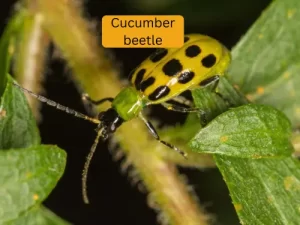
Cucumber beetle in cucumber
Features: Thus, these beetles can either have stripes (yellow with black lines) or spots (yellow with black dots). They measure approximately 1/4 inch.
Symptoms: They feed on the leaves, stems and cucumber fruits. It also carries bacterial wilt and cucumber mosaic virus.
Management: Seedlings should be protected with floating row covers. Trap crops like sacrificial squash relatives can attract beetles away.
Solution: To combat Cucumber Beetles using ‘Myco Pestop‘, an organic insecticide with Metarhizium anisopliae as the active ingredient, apply it directly to the soil or plants. This fungus infects and kills beetles upon contact. For effective control, use 1-2 ml per liter in early infestation stages and repeat every 5-10 days. For severe cases, a combination with chemical pesticides might be necessary for initial knockdown. ‘Myco Pestop’ is environmentally friendly and supports IPM programs, offering a sustainable solution against beetle infestations in cucumbers.
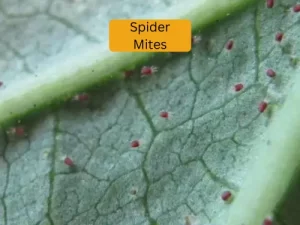
Spider mites in cucumber
Features: Microscopic, spider-like mites, a cucumber pests that are usually red or brown. In hot and dry environments they grow luxuriantly.
Symptoms: Leaf stippling, yellowing and fine webbing on the leaf undersides. High level of infestations result in the dropping of leaves.
Management: Increase humidity around plants, as mites prefer dry conditions. Introduce predatory mites. In severe cases, miticides can be used, but always follow organic options first, like neem oil.
Solution: To manage Spider Mites on cucumbers, ‘Beveria WP‘ and ‘Metarhizium anisopliae‘ can be effective solutions. These bioinsecticides, based on naturally occurring fungi, provide control against Spider Mites among other pests. They work by attaching to the pests, penetrating their bodies, and releasing toxins. For application, a foliar spray or soil drench can be used, with specific mixing rates provided by the manufacturer. It’s important to follow the proper mixing and application guidelines to ensure effectiveness.
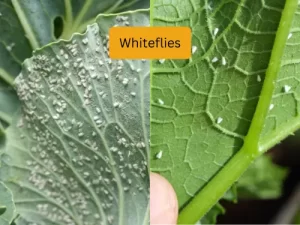
Whiteflies in cucumber
Features: Any of numerous small winged insects that aggregate in great numbers on the surface of leaves. They are either white or yellowish in colour.
Symptoms: Like aphids, they make the leaves turn yellow and produce honeydew. In the case of heavy infestations, plants weakened considerably.
Management: Yellow sticky traps serve to monitor and even eliminate this pest. Horticultural oils and insecticidal soaps are effective. Encourage natural predators like ladybugs.
Solution: To manage Whiteflies on cucumbers using ‘Beveria WP,’ a bioinsecticide based on Beauveria bassiana, follow these guidelines: Mix the product as per instructions, typically 0.5-1.0 gram per liter of water for foliar spray or 2-3 grams for soil application. Spray or drench every 7-10 days until control is achieved. Ensure proper pre-mixing to avoid residue and ensure effectiveness. ‘Beveria WP’ is eco-friendly, safe for humans and the environment, and works well in integrated pest management programs.
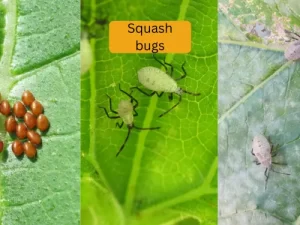
squash bugs in cucumber
Features: Squash Bugs are medium-sized insects with a flat, brown body. They often hide under leaves or near the base of the plant.
Symptoms: These pests suck sap from the leaves, causing yellow spots that later turn brown and dry. Heavy infestations can lead to wilting and the death of young plants. Squash Bugs also emit an unpleasant odor when disturbed.
Management: Physical removal of bugs and eggs can be effective in small gardens. Floating row covers can prevent them from accessing plants, but be sure to remove during flowering to allow for pollination. Encouraging natural predators, like predatory beetles, and using companion planting with nasturtiums or tansy can help manage their population.
Solution: To address Squash Bugs in cucumbers, ‘Metarhizium anisopliae‘ serves as an effective biological solution. This product is a biocontrol agent that targets a broad spectrum of pests, including Squash Bugs. Apply 1-2 grams of the product per liter of water for foliage treatment, ensuring coverage on both sides of leaves, or similarly for soil application around the plant base. Additionally, it can be mixed with dried farmyard manure before transplanting for broad-area treatment. ‘Metarhizium anisopliae’ not only controls pests but also enhances plant health and production, offering a sustainable pest management approach.
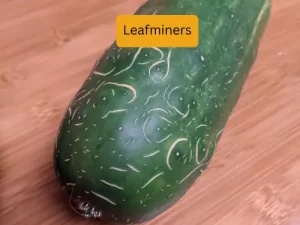
Leafminers in cucumber
Features: Leafminers are the larvae of various insects such as flies, moths, and beetles. They create visible tunnels or trails inside the leaf tissue, which can appear as squiggly lines across the leaves.
Symptoms: Infestation is indicated by the distinctive trails left on leaves, which may lead to leaf curling and reduced photosynthesis. Severe infestations can significantly affect plant health and yield.
Management: Monitoring and removing infested leaves early can help reduce their numbers. Beneficial insects, such as parasitic wasps, often control leafminer populations effectively. Floating row covers can prevent adults from laying eggs on the plants. Chemical treatments are available but should be used as a last resort to avoid harming beneficial insects. Introducing or encouraging natural predators in the garden is a sustainable approach to managing leafminers.
Solution: To address Leafminers pests in cucumbers, ‘BT Thuricide,’ a bioinsecticide derived from Bacillus thuringiensis, can be utilized. This natural product is effective against a wide range of pests, including Leafminers, by producing toxins that target the larvae after ingestion, leading to their death. To apply, mix 0.5-1.0 gram of ‘BT Thuricide’ per liter of water for foliar spray, and spray every 7-10 days until you achieve control. This eco-friendly option is safe for the environment and beneficial for integrated pest management programs.
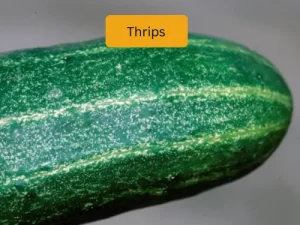
Thrips in cucumber
Features: Thrips are tiny, slender insects that can be difficult to see without magnification. They have fringed wings and come in various colors, from yellow to brown or black. Thrips are often found on the undersides of leaves or within flower buds.
Symptoms: Their feeding activity can cause leaves to develop a silvery, speckled appearance, and flowers may exhibit distortion or discoloration. Thrips can also transmit plant viruses, compounding the damage.
Management: Reducing thrip populations involves a combination of cultural, biological, and, if necessary, chemical methods. Removing weeds and plant debris can help eliminate their breeding grounds. Introducing beneficial predators, such as lacewings and predatory mites, can control their numbers naturally. For severe infestations, insecticidal soaps or neem oil sprays can be effective. It’s also beneficial to cover plants with floating row covers to prevent thrips from reaching them.
Solution: To address Thrips pests in cucumbers, ‘Beveria WP,’ a bioinsecticide derived from Beauveria bassiana, offers a natural solution. Effective against Thrips, it functions by attaching spores to the pests, which then penetrate and kill them through toxin release. For treatment, mix 0.5-1.0 gram of ‘Beauveria WP’ per liter of water for foliar spray, ensuring comprehensive plant coverage. Apply every 7-10 days until control is achieved, avoiding direct light or heat during application to protect the spores. This eco-friendly method is safe for humans and beneficial for integrated pest management programs.
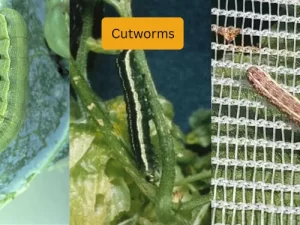
Cutworms in cucumber
Features: Cutworms, cucumber pests, are the caterpillar stage of certain nocturnal moths. They are stout, soft-bodied larvae, varying in color from grey to brown or black, and often curl into a C-shape when disturbed. Cutworms typically hide in the soil or under debris during the day and feed at night.
Symptoms: These pests are known for cutting off young plants at or just below the soil surface, especially seedlings, which can result in significant early plant loss. They can also girdle the stems of older plants.
Management: To manage cutworms, clear the garden of plant debris and till the soil before planting to disturb their lifecycle. Collars made from cardboard or plastic placed around the seedlings’ stems can effectively prevent cutworm damage. Attracting natural predators, such as birds and ground beetles, can help reduce cutworm populations. For severe infestations, baited traps or appropriate insecticides applied around the base of plants can provide control. Planting a bit later in the season, when cutworms are less active, can also be a beneficial strategy.
Solution: To manage Cutworms in cucumbers, ‘Met Zone‘ offers an organic solution. This product, based on Metarhizium anisopliae spores, targets Cutworms by infecting them at all life stages. For application, distribute the granular insecticide evenly into moist soil, ensuring thorough integration into the medium. ‘Met Zone’ not only controls Cutworms but also benefits plant health and yield by offering a broad-spectrum, eco-friendly pest control option, compatible with organic farming practices.
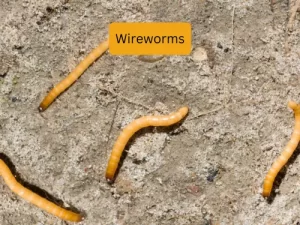
Wireworms in cucumber
Features: Wireworms are the soil-dwelling larvae of click beetles, slender and hard-bodied, with a coloration that ranges from shiny yellow to brown. They are particularly problematic in gardens where grass or weeds were recently turned under, as they prefer these conditions.
Symptoms: These pests target seeds and roots, leading to poor germination, stunted growth, or the sudden wilting and death of plants. Wireworms are known for boring holes into tubers and root crops, making them unsuitable for consumption.
Management: Managing wireworms starts with cultural practices such as rotating crops and removing plant residues to reduce their habitat. Solarization or flooding of the soil may reduce their numbers by making conditions less favorable for them. Using bait traps (pieces of potato or carrot buried in the soil) can help monitor and reduce wireworm populations. Encouraging natural predators, such as birds and beneficial nematodes, can also help control their spread. For persistent problems, consider planting resistant crop varieties or using appropriate soil insecticides following label instructions carefully.
Solution: To manage Wireworms in cucumbers, ‘Met Zone,’ a granular insecticide that incorporates the fungus Metarhizium anisopliae, can be utilized. This product targets a range of soil and surface insects, including Wireworms, by infecting and subsequently killing them through the growth of the fungus inside their bodies. For effective application, ‘Met Zone’ should be evenly distributed in moist soil, preferably during cooler times of the day, to ensure the best performance and minimal impact on non-target species. This method offers an eco-friendly and organic solution for controlling Wireworm populations in cucumber crops.
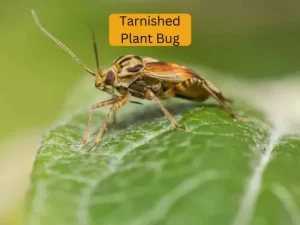
Tarnished plant bug in cucumber
Features: The Tarnished Plant Bug is cucumber pests, about 1/4 inch long, with a mottled brown and yellow appearance. It has piercing-sucking mouthparts that it uses to feed on the sap of a wide variety of plants. These bugs are quick movers and can fly, making them a challenge to catch.
Symptoms: Damage includes distorted growth, such as stunted or deformed leaves and flowers. They can also cause spotting or discoloration on fruits and vegetables. Their feeding activity can result in significant yield loss, especially in fruit and vegetable crops.
Management: Managing Tarnished Plant Bugs involves a combination of cultural, mechanical, and chemical strategies. Removing weeds and debris from around the garden can eliminate their hiding places and reduce overwintering sites. Using floating row covers can protect plants from these pests while allowing light and water to reach the plants. Encouraging or introducing natural predators like lacewings and ladybugs can help control their population. In severe cases, targeted use of insecticides may be necessary, but always consider the impact on beneficial insects and follow label directions carefully.
Solution: To combat Tarnished Plant Bug pests in cucumbers, ‘Metarhizium anisopliae‘, a biological control agent, can be utilized. This eco-friendly solution involves applying a powder or granular formulation of the fungus directly to affected areas or the soil surrounding plants. The recommended dosage ranges from 1-2 grams per liter of water for foliage spray or soil application. ‘Metarhizium anisopliae’ works by infecting and killing a broad spectrum of insect pests, offering a sustainable alternative to chemical pesticides.
 Features: Nematodes affecting cucumbers are tiny, soil-dwelling worms that target the roots, causing significant damage. These microscopic pests, primarily root-knot nematodes, create galls on roots that block nutrient and water uptake. Thriving in warm, sandy soils, they affect a wide range of crops besides cucumbers.
Features: Nematodes affecting cucumbers are tiny, soil-dwelling worms that target the roots, causing significant damage. These microscopic pests, primarily root-knot nematodes, create galls on roots that block nutrient and water uptake. Thriving in warm, sandy soils, they affect a wide range of crops besides cucumbers.
Symptoms: Infected cucumber plants show stunted growth, leaf yellowing, wilting under heat, and reduced vigor. Root inspection reveals swollen, knotty growths. Infestations can lead to diminished yields and even plant death.
Management: Effective control combines cultural, biological, and chemical strategies. Crop rotation with nematode-resistant or non-host plants, like marigolds, disrupts their lifecycle. Soil solarization and organic amendments improve soil health and reduce nematode populations. Biological controls, such as predatory microorganisms, offer a sustainable option. Chemical nematicides should be used sparingly, following label directions to minimize environmental impact.
Solution: To tackle nematode issues in agriculture, you can use “Nema Pro,” a biological nematicide derived from the naturally occurring fungus Purpureocillium lilacinum. It’s effective against various nematode stages, including eggs, juveniles, and adults, enhancing crop resilience by strengthening roots and promoting growth. Apply 3-4.5 kilograms per acre during planting, depending on nematode density, and reapply every 28 days for season-long control. It’s crucial to avoid mixing Nema Pro with certain fungicides and to maintain a spray solution pH of 6-7 for optimal effectiveness. This solution is suitable for organic farming as it leaves no harmful residues.
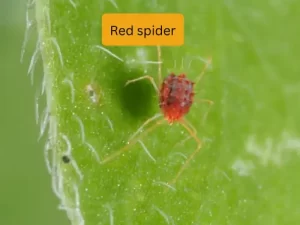
Red spider in cucumber
Features: The Red Spider Mite is a minuscule pest, barely visible to the naked eye, with a distinctive red color. These mites thrive in hot, dry conditions, spinning fine webs on the undersides of cucumber leaves where they pierce the plant tissues to feed on sap. Their rapid reproduction rates can lead to large infestations in a short period.
Symptoms: Infected cucumber plants exhibit yellowing or bronzing of leaves, leading to reduced growth and wilted, unhealthy plants. Severe infestations can significantly decrease yield and fruit quality.
Management: Controlling Red Spider Mites requires a multifaceted approach. Regularly misting plants can create a less favorable environment for mites. Removing infested leaves and disposing of them properly helps reduce the mite population. Introducing natural predators, such as predatory mites or ladybugs, can effectively manage mite numbers. In cases of heavy infestation, miticides may be used with caution, considering their effects on non-target species and following all application guidelines.
Solution: For combating red spider mites, “Beveria WP,” which utilizes the fungus Beauveria bassiana, can be applied effectively. Mix this bioinsecticide at a concentration of 0.5-1.0 gram per liter of water for foliar applications to ensure thorough coverage of affected plants. Repeat applications every 7-10 days until the pest population is under control for ongoing management. Beveria WP provides a natural and environmentally safe option, ideal for integrated pest management strategies.
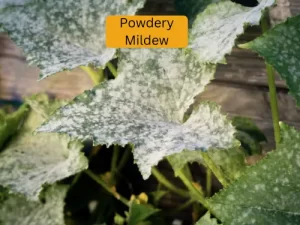
Powdery mildew in cucumber
Features: Powdery Mildew is a fungal disease, affecting cucumber plants, characterized by white or gray powdery growth on leaves. This common pathogen prefers warm, dry conditions combined with high humidity levels around the plants.
Symptoms: Infected cucumbers display white powdery spots on leaves, which can spread to cover the entire leaf surface. Severely affected leaves may yellow, dry out, and fall off, leading to reduced photosynthesis and weakened plants.
Management: Managing Powdery Mildew involves a mix of preventative and responsive measures. Ensure adequate spacing between plants to improve air circulation and reduce humidity. Remove and dispose of infected plant parts promptly. Use fungicides specifically labeled for Powdery Mildew control, following application guidelines carefully. For organic control, consider sulfur-based fungicides or baking soda solutions, while also exploring resistant cucumber varieties.
Solution: To manage Powdery Mildew in cucumbers, Trianum-V, a natural fungicide with Trichoderma harzianum, is effective. It works by outcompeting harmful fungi for space and nutrients and inducing systemic resistance in plants. For best results, apply it as a preventive measure, ensuring thorough coverage, especially under leaves, and follow a schedule based on disease pressure. Trianum-V is safe for organic production and has a wide compatibility with other products, excluding copper-based fungicides.
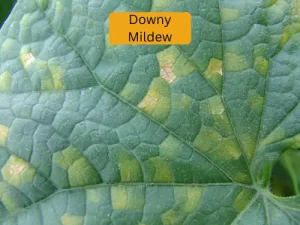
Downy mildew in cucumber
Features: Downy Mildew in cucumbers is caused by the water mold Pseudoperonospora cubensis. It thrives in cool, wet conditions, and spreads rapidly through moisture. This pathogen primarily affects the leaves, but can impact the entire plant’s health.
Symptoms: The disease manifests as yellow, angular spots on the upper leaf surfaces, with a fluffy, grayish-purple mold growth on the undersides. As it progresses, leaves can become brown, dry, and brittle, leading to reduced photosynthesis and plant vigor.
Management: Managing Downy Mildew involves several strategies. Plant resistant cucumber varieties when available. Ensure good air circulation around plants to reduce leaf wetness. Practice crop rotation and remove plant debris to minimize the source of infection. You may apply fungicides as a preventive measure, particularly when conditions favor disease development. Always follow application guidelines carefully to protect beneficial organisms.
Solution:
To combat Downy Mildew in cucumbers, consider using ‘Trianum V,’ a natural fungicide derived from Trichoderma harzianum. This biocontrol agent works by outcompeting harmful fungi for space and nutrients, inducing systemic acquired resistance (SAR) and induced systemic resistance (ISR) in plants, which enhances their ability to fend off diseases. For effective use, apply ‘Trianum V’ as a foliar spray, ensuring thorough coverage, especially on the undersides of leaves. It’s suitable for use in organic farming, offering a sustainable solution to manage Downy Mildew without harming beneficial organisms or the environment.
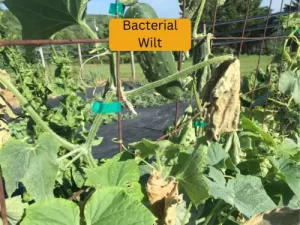
Bacterial wilt in cucumber
Features: Bacterial Wilt is a serious disease of cucumbers caused by the bacterium Erwinia tracheiphila. It’s transmitted through the feeding activities of cucumber beetles. The bacterium obstructs the plant’s water transport system, leading to wilting.
Symptoms: The disease first manifests as a wilting of the leaves, which progresses until the entire plant wilts and dies. Infected plants may initially recover at night, but as the disease advances, recovery diminishes, leading to complete collapse.
Management: Management focuses on preventing cucumber beetle infestations. Keep the garden free of debris and weeds that can harbor beetles. Use row covers to protect young plants, removing them during flowering to allow for pollination. Apply insecticides to control beetle populations, and remove and destroy infected plants immediately to prevent the spread of the disease.
Solution: To address Bacterial Wilt in cucumbers, ‘Bactonus‘ offers an organic solution by harnessing the power of beneficial bacteria such as Bacillus safensis, Bacillus velezensis, and Pseudomonas chlororaphis. This product prevents and controls bacterial diseases by colonizing plant roots, producing antibacterial substances, and improving the root environment. It’s applied through seedbed nursing, soil treatment, or foliar spray at specific dosages and intervals. ‘Bactonus’ is beneficial for various crops, including cucumbers, and enhances plant health and yield without developing resistance.
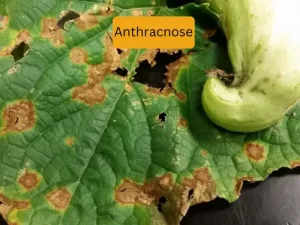
Anthracnose in cucumber
Features: Anthracnose in cucumbers is caused by the fungus Colletotrichum orbiculare. It thrives in warm, wet conditions, attacking leaves, stems, and fruit. The disease is known for its ability to spread rapidly through water splash and infected plant debris.
Symptoms: The disease manifests as sunken, water-soaked spots on leaves, fruits, and stems. Leaves may yellow and wither, while fruits develop dark, sunken lesions, making them unmarketable.
Management: Managing Anthracnose involves practicing crop rotation and ensuring good air circulation through proper spacing. Remove and destroy infected plant debris to reduce disease spread. Use resistant cucumber varieties when available. Use fungicides as part of an integrated management approach, considering their impact on non-target organisms and following application guidelines carefully, for effectiveness.
Solution: To manage Anthracnose diseases in cucumbers, ‘Trianum Shield‘ can be utilized. This biofungicide, with Trichoderma harzianum as its active ingredient, not only controls soil-borne diseases but also stimulates plant growth and improves soil structure. For best results, apply 3 kgs per acre early in the season or as needed. It’s compatible with a variety of application methods, including spraying and soil drenching, and works across a wide range of temperatures and pH levels. ‘Trianum Shield’ is effective, leaves no residue, and is suitable for organic production.
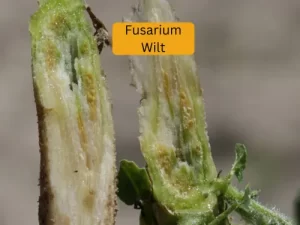
Fusarium Wilt in cucumber
Features: Fusarium Wilt in cucumbers is caused by the fungus Fusarium oxysporum f.sp. cucumerinum. This soil-borne pathogen infects the plant’s vascular system, obstructing water and nutrient flow. The fungus thrives in warm soil and can persist for years.
Symptoms: Early signs include yellowing and wilting of lower leaves, progressing to the entire plant. Infected plants often exhibit stunted growth and may eventually die. Cutting the stem crosswise reveals a brown discoloration of the vascular tissues.
Management: Managing Fusarium Wilt involves preventative and cultural strategies. Plant resistant cucumber varieties when available. Rotate crops to non-host plants for at least 3-4 years. Maintain soil health and moisture levels to reduce stress on plants. Avoid wounding plants, as injuries can serve as entry points for the fungus. Soil fumigation or solarization may be effective in severe cases, but these methods require careful consideration to avoid harming beneficial soil organisms.
Solution: To combat Fusarium Wilt in cucumbers, ‘Trianum Shield,’ a biofungicide with the active ingredient Trichoderma harzianum, offers a sustainable solution. This product promotes plant growth, improves soil structure, and establishes a symbiotic relationship with plant roots, providing protection against soil-borne diseases like Fusarium Wilt. For best results, apply 3 kg per acre early in the season or to mature crops via spraying, drip-irrigation, or soil drenching, under a wide range of temperatures and soil pH levels. ‘Trianum Shield’ is suitable for organic production, leaving no residue.
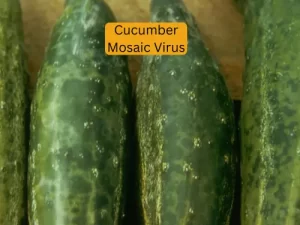
Cucumber Mosaic Virus
Features: Cucumber Mosaic Virus (CMV) is a widespread viral disease affecting cucumbers, characterized by its ability to infect over 1200 species of plants. It’s transmitted by aphids and through mechanical means, such as handling infected plants and then touching healthy ones.
Symptoms: Symptoms include mosaic patterns of dark and light green on leaves, stunted growth, malformed leaves, and reduced yield. Fruits may also show discoloration, uneven ripening, and warty growths.
Management: Managing CMV focuses on preventive measures. Select resistant cucumber varieties when available. Control aphid populations through natural predators or insecticidal soap. Avoid working with plants during damp conditions to minimize mechanical transmission. Clean tools and hands after handling infected plants to prevent spread. Chemical controls cannot treat the virus once a plant is infected, so you should remove and destroy affected plants to halt further spread.
Solution: To address the Cucumber Mosaic Virus, consider using “Bactonus,” a biocontrol agent designed to enhance plant immunity and suppress virus transmission. For effective management, apply Bactonus according to the recommended guidelines, focusing on preventive measures and regular treatment to maintain plant health. This solution not only helps manage the virus but also supports overall plant vigor, making it a sustainable choice for integrated pest management.
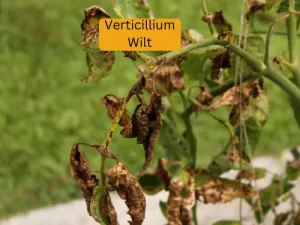
Verticillium Wilt in cucumber
Features: Verticillium Wilt is a soil-borne fungal disease caused by Verticillium dahliae and V. albo-atrum. It affects cucumber plants by invading the xylem tissue, leading to the obstruction of water flow.
Symptoms: Initial signs include wilting of lower leaves, which may recover at night and worsen during the day. As the disease progresses, leaves turn yellow, wither, and die. The vascular tissue may also show browning, evident in stem cross-sections.
Management: Control strategies focus on preventive measures. Crop rotation with non-susceptible plants for at least three to four years is recommended. Utilizing disease-resistant cucumber varieties and ensuring good soil drainage can help reduce the risk of infection. Soil fumigation and solarization are additional options, though they may not be feasible for all gardeners. Avoid over-fertilization, especially with nitrogen, to reduce plant susceptibility.
Solution: To combat Verticillium wilt, you can use “Cropium,” a biocontrol agent formulated to enhance plant resistance and health. Apply this treatment directly to the soil or use it as a foliar spray to protect plants from the onset and spread of Verticillium wilt. Regular application as per the recommended guidelines ensures the best defense against this fungal disease, promoting healthier and more resilient plants. Always refer to the product label or visit the manufacturer’s website for specific application instructions and rates.
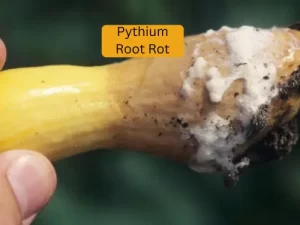
Pythium Root Rot in cucumber
Features: Pythium Root Rot is a fungal disease affecting cucumber roots, caused by various Pythium species. It thrives in overly moist soil conditions and can affect plants at any growth stage.
Symptoms: Initial signs include wilting, yellowing, and stunting of cucumber plants. The roots turn soft, brown, and may rot away, severely impacting nutrient and water uptake.
Management: To manage Pythium Root Rot, ensure good drainage in the soil and avoid overwatering. Plant cucumbers in well-aerated soil and use sterile potting mixes for seedlings. Crop rotation and the use of fungicide treatments may be necessary for severe infestations. Implementing a sound water management plan is crucial to prevent the conditions that favor the development of this disease.
Solution: To tackle Pythium root rot, consider using “Trianum Shield,” a biological fungicide that enhances soil health and plant resilience. This product works by colonizing the root system, creating a protective barrier against the pathogen, and promoting a beneficial microbial environment. Apply Trianum Shield directly to the soil according to the recommended dosage to prevent and control the spread of this disease.
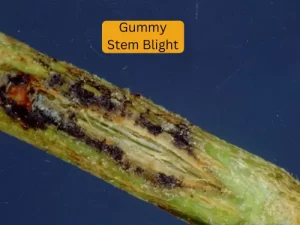
Gummy Stem Blight in cucumber
Features: Gummy Stem Blight, caused by the fungus Didymella bryoniae, primarily affects cucumber stems, leaves, and fruit. The disease favors warm, wet conditions and can spread rapidly in greenhouses and field settings.
Symptoms: Early signs include water-soaked spots on leaves and stems that develop into brown, gummy lesions. As the disease progresses, leaves may yellow and wilt, and the stem can crack, exuding a gummy substance. Fruit infections lead to black, sunken areas.
Management: Prevention is key with Gummy Stem Blight. Use disease-free seeds and implement crop rotation. Improve air circulation around plants by spacing them properly and controlling weeds. Apply fungicides as a protective measure in areas with a history of the disease. Remove and destroy infected plant material to reduce the spread.
Solution: For treating gummy stem blight, “Cropium” can be an effective biocontrol agent. This product is designed to enhance plant immunity and suppress disease development. Regular application of Cropium, following the specified guidelines, can prevent and control the progression of gummy stem blight by promoting healthier plants and reducing pathogen impact.
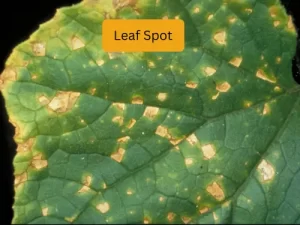
Leaf Spot in cucumber
Features: Leaf Spot in cucumbers is a fungal disease caused by Cercospora cucumeris. It primarily affects the leaves but can also appear on stems and fruits. The disease favors warm, humid conditions and can spread rapidly.
Symptoms: Characterized by small, circular to irregularly shaped spots on leaves. These spots are initially dark green to black and may turn yellow or brown with a dry, brittle texture. Severely infected leaves may wither and fall off, impacting overall plant health and yield.
Management: To manage Leaf Spot, practice crop rotation and avoid overhead watering to reduce leaf wetness. Remove and destroy infected plant debris. Ensure good air circulation around plants. Apply fungicides as necessary, following label instructions carefully. Resistant cucumber varieties, when available, should be used to minimize disease impact.
Solution: For controlling leaf spot, ‘Metilo‘ is a recommended solution. It’s a biological fungicide that works by enhancing plant defenses and fostering a beneficial microbial environment around the roots, which helps in suppressing the pathogens responsible for leaf spot. Apply Metilo according to the manufacturer’s instructions, focusing on both preventive and active disease management practices. This treatment is ideal for integrated disease management programs aiming for sustainability and reduced chemical usage.

Corynespora Leaf Spot on cucumber
Features: Corynespora leaf spot is a fungal disease affecting cucumber plants. It manifests as small, dark spots on the leaves, which gradually enlarge and develop a characteristic bull’s-eye pattern. In severe cases, the spots may coalesce, leading to extensive defoliation.
Symptoms: Initial symptoms include the appearance of small, circular lesions on cucumber leaves, typically starting from the lower foliage. As the disease progresses, the spots enlarge and develop a dark brown to black coloration with a lighter center. In humid conditions, a grayish mold may develop on the lesions. Severe infections can result in premature leaf drop, reducing the plant’s vigor and yield potential.
Management: Cultural practices such as crop rotation and maintaining proper spacing between plants can help reduce the spread of Corynespora leaf spot. Additionally, ensuring adequate air circulation and avoiding overhead irrigation can create an environment less favorable for fungal growth. Remove and destroy infected plant debris promptly to prevent further spread of the disease.
Solution: To manage Corynespora leaf spot in cucumbers, “Trianum V” can be employed effectively. This biological fungicide boosts the plant’s resistance and establishes a healthier root zone, making it more difficult for the Corynespora cassiicola fungus to infect the plant. For best results, apply Trianum V according to the recommended dosages and application guidelines provided by the manufacturer

Features: Various pathogens such as Pseudoperonospora cubensis or Sclerotinia sclerotiorum cause Cucumber Vine Blight, a fungal disease. It typically manifests as dark lesions on leaves, stems, and fruits of cucumber plants. The lesions may start as small water-soaked spots and rapidly expand, eventually leading to the wilting and death of the plant.
Symptoms: Cucumber Vine Blight induces wilting, yellowing, and necrosis of leaves and stems. Infected areas may develop a fuzzy, white or gray mold growth. Fruits may also become infected, showing dark spots or lesions, rendering them inedible.
Management: Management of Cucumber Vine Blight involves cultural practices and chemical treatments. Practices such as crop rotation, ensuring proper spacing between plants, and avoiding overhead irrigation can help reduce the spread of the disease. Apply fungicides with active ingredients like chlorothalonil or copper preventatively or curatively to control the disease.
Solution: For combating cucumber vine blight, “Cropium” offers an effective solution. As a biological control agent, Cropium supports plant health by enhancing natural resistance against pathogens like those causing vine blight. Apply Cropium as per the manufacturer’s guidelines, focusing on both prevention and treatment to ensure robust plant growth and minimize disease impact. Regular application during susceptible growth periods can significantly reduce the incidence of vine blight.

Features: Pathogenic bacteria, often from the genus Pseudomonas or Xanthomonas, cause bacterial gum disease in cucumbers. These bacteria infect the cucumber plant, typically entering through wounds or natural openings like stomata.
Symptoms: The disease manifests as water-soaked lesions on leaves, stems, and fruits, which may later turn brown or black. As the infection progresses, affected areas develop a slimy, gummy exudate, giving the disease its name. Severe infections can lead to wilting, leaf drop, and reduced fruit quality and yield.
Management: Cultural practices play a crucial role in managing bacterial gum disease. This includes practicing crop rotation, maintaining proper spacing between plants for good airflow, and avoiding overhead irrigation to reduce moisture on foliage. Sanitation is essential, with removal and destruction of infected plant debris to prevent further spread. Growers often use copper-based fungicides for bacterial disease management, though their effectiveness can vary.
Solution: To address Bacterial gum disease in cucumbers, “Bactonus” is a highly recommended treatment. This biocontrol product enhances the plant’s own defenses, creating an environment that suppresses the disease-causing bacteria. Apply Bactonus according to the recommended guidelines to effectively manage and prevent the progression of bacterial gum disease. Ensure consistent application throughout the growing season for optimal results.
Managing pests and diseases in cucumber cultivation is a dynamic and ongoing process. It requires a combination of good cultural practices, vigilant monitoring, and timely intervention. By understanding the specific threats to cucumbers and employing integrated pest and disease management strategies, growers can ensure healthy plants and bountiful harvests. Remember, prevention is always better than cure, so start with resistant varieties and create an environment less conducive to pests and diseases. By implementing these practices, you can grow cucumbers successfully with minimal impact from these common challenges.

